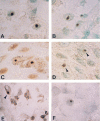Nonneural nuclear inclusions of androgen receptor protein in spinal and bulbar muscular atrophy
- PMID: 9736019
- PMCID: PMC1853004
- DOI: 10.1016/S0002-9440(10)65612-X
Nonneural nuclear inclusions of androgen receptor protein in spinal and bulbar muscular atrophy
Abstract
Spinal and bulbar muscular atrophy is an X-linked motor neuronopathy caused by the expansion of an unstable CAG repeat in the coding region of the androgen receptor (AR) gene. Nuclear inclusions of the mutant AR protein have been shown to occur in the spinal motor neurons of spinal and bulbar muscular atrophy (Li M, Kobayashi Y, Merry D, Tanaka F, Doyu M, Hashizume Y, Fischbeck KH, Sobue G: Nuclear inclusions in spinal and bulbar muscular atrophy. Ann Neurol 1998 (in press)). In this study, we demonstrate the tissue-specific distribution, immunochemical features, and fine structure of nuclear inclusions of spinal and bulbar muscular atrophy. Nuclear inclusions were observed in affected spinal and brainstem motor neurons, but not in other, nonaffected neural tissues. Similar nuclear inclusions occurred in nonneural tissues including scrotal skin, dermis, kidney, heart, and testis, but not in the spleen, liver, and muscle. These inclusions had similar epitope features detectable by antibodies that recognize a small portion of the N-terminus of the AR protein only, and they were ubiquitinated. Electron microscopic immunohistochemistry showed dense aggregates of AR-positive granular material without limiting membrane, both in the neural and nonneural inclusions. These findings indicate that nuclear inclusions of AR protein are present in selected nonneural tissues as well as in neurons that degenerate in spinal and bulbar muscular atrophy, suggesting that a common mechanism underlies in the formation of neural and nonneural nuclear inclusions.
Figures




References
-
- Kennedy WR, Alter M, Sung JH: Progressive proximal spinal and bulbar muscular atrophy of late onset: a sex-linked recessive trait. Neurology 1968, 18:671-680 - PubMed
-
- Sobue G, Hashizume Y, Mukai E, Hirayama M, Mitsuma T: X-linked recessive bulbospinal neuronopathy, a clinicopathological study. Brain 1989, 112:209-232 - PubMed
-
- Li M, Sobue G, Doyu M, Mukai E, Hashizume Y, Mitsuma T: Primary sensory neurons in X-linked recessive bulbospinal neuronopathy: histopathology and androgen receptor gene expression. Muscle Nerve 1995, 18:301-308 - PubMed
-
- La Spada AR, Wilson EM, Lubahn DB, Harding AE, Fischbeck KH: Androgen receptor gene mutations in X-linked spinal and bulbar muscular atrophy. Nature 1991, 352:77-79 - PubMed
-
- Doyu M, Sobue G, Mukai E, Kachi T, Yasuda T, Mitsuma T, Takahasi A: Severity of X-linked recessive bulbospinal neuronopathy correlates with size of the tandem CAG repeat in androgen receptor gene. Ann Neurol 1992, 32:707-710 - PubMed
Publication types
MeSH terms
Substances
LinkOut - more resources
Full Text Sources
Other Literature Sources
Medical
Research Materials

